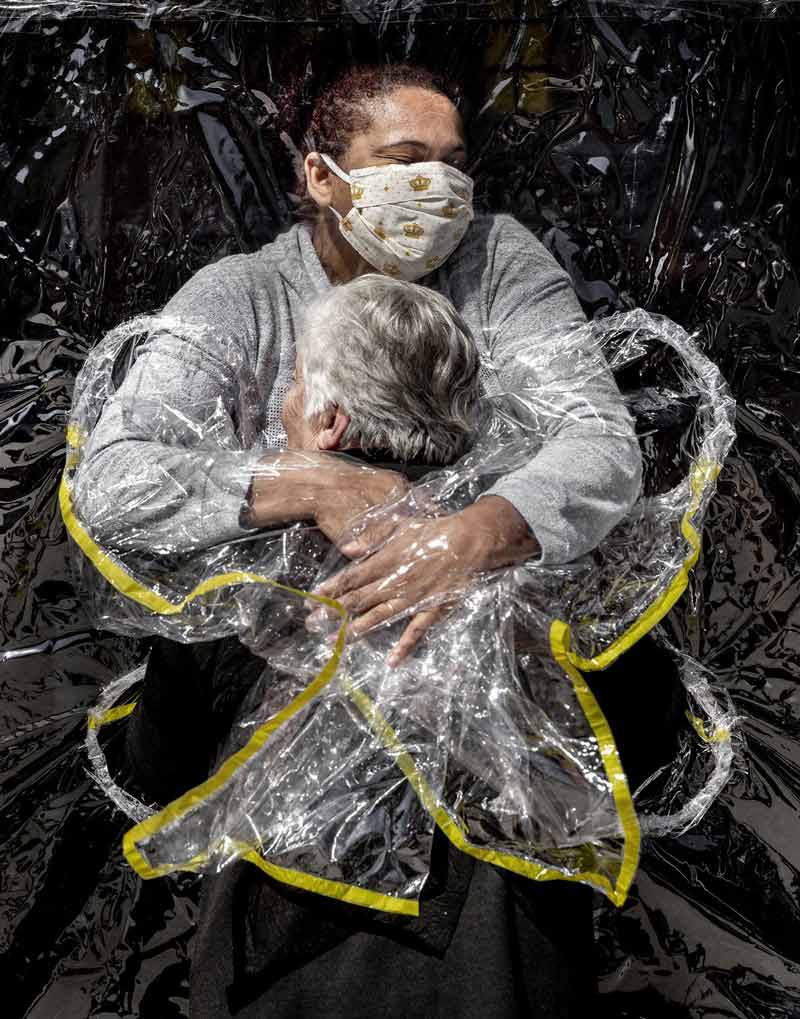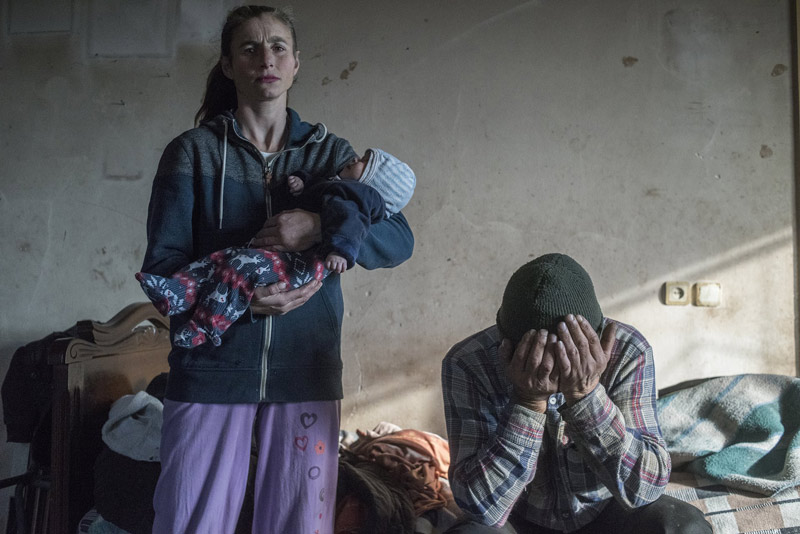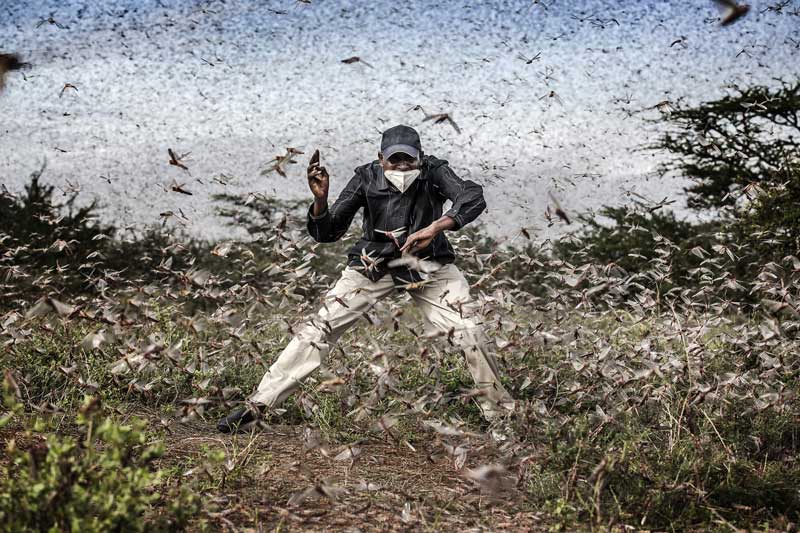
Danish photographer Mads Nissen’s photograph, entitled The First Embrace, earned Photo of the Year honours on top of the General News (Singles) prize at the World Press Photo competition. [Mads Nissen/Politiken/Panos Pictures/World Press Photo 2021]
The World Press Photo (WPP) exhibition has returned to Canada, showing at the Canadian War Museum in Ottawa after a one-year, pandemic-imposed hiatus.
And this year’s version, featuring 159 of the top entries from the world’s most prestigious photojournalism competition, has more than its usual share of misery, suffering and tumult, interpreted with exquisite impact by a select few shooters.
The pandemic is a complex story of health, science, economics and politics. But, at its core, it is most of all a human story.
Predictably, perhaps, COVID-19 stole the show: an image by Danish lensman Mads Nissen entitled The First Embrace earned Photo of the Year honours on top of the General News (Singles) prize. It depicts a nurse hugging an elderly woman through a protective curtain after five months of virtual isolation in a long-term care home.
More than just recording events as they happen, at their best and most relevant the photojournalist must find simple, direct, yet profound ways to capture the essence of a story—ways that make viewers stop and look, feel and understand. To make them care.
The pandemic is a complex story of health, science, economics and politics. But, at its core, it is most of all a human story, a story of isolation, suffering, heartbreak and death—more than four million of them worldwide.
In Brazil, President Jair Bolsonaro repeatedly dismissed warnings about the pandemic’s severity and the dangers of the virus. He undermined state quarantine measures and encouraged Brazilians to keep working. As a result, Brazil’s 2020 pandemic record was among the world’s worst, with more than 7.7 million reported cases and 195,000 deaths.
In his single image of nurse Adriana Silva da Costa Souza embracing 85-year-old Rosa Luzia Lunardi through a plastic curtain at the Viva Bem (good life) care home in São Paulo, Nissen cut through all the debate, disinformation and hyperbole.
It depicts that most basic of human needs, to be touched and feel the warmth of others—even through protective plastic.
“To me, this is a story about hope and love in the most difficult times,” said Nissen, a widely published shooter who also won the 2015 WPP Photo of the Year with his photograph of a gay couple in Russia, a country known for hostility towards LGBTQ people.
He said he was moved to document the situation in Brazil in the face of Bolsonaro’s pandemic denials, in which the president characterized the virus as “a little flu.” Nissen heard of the so-called “hugging curtains” that allowed patients to hug and be hugged without risking COVID transmission.
“The secret behind my photography is trying to create this empathy that we can all hopefully relate to, despite our differences.”
“It all happened one day, just outside of São Paulo,” he explained. As he entered the home, he said, he knew “this is going to be amazing.”
“The plastic sheet was transparent. The light was beautiful. So all I had to do was [just speak] with the people, try to connect, just be quiet and try to capture those strong emotions that were unfolding in front of me.
“The secret behind my photography is trying to create this empathy that we can all hopefully relate to, despite our differences,” he said. “And to me that’s the most important thing about photography: that we can, in the split second that we see the images, feel how it must be to be that other person.
“To get a sense of what unites us, as human beings.”

Jeremy Lempin photographed cancer patient Marion, 24, embracing her seven-year-old son Ethan while Peyo, a horse used in animal-assisted therapy, stands over them in the Séléne Palliative Care Unit at the Centre Hospitalier de Calais, in Calais, France. [Jeremy Lempin/World Press Photo 2021]
This year’s WPP drew more than 74,470 entries taken by 4,315 photographers from 130 countries. An independent jury honoured 45 photographers from 28 countries in eight categories: Contemporary Issues, Environment, General News, Long-Term Projects, Nature, Portraits, Sports and Spot News.
This is the 13th time the war museum has exhibited the touring show, which is expected to be seen by four million people in 120 cities in 50 countries.
The exhibition includes several pandemic-related photographs, among them Joshua Irwandi’s haunting image from Indonesia of a COVID victim’s body wrapped in plastic and Ivan Macias’ portrait of a Mexican doctor with marks from protective goggles pressed into her face.
As always, wars and their effects were prominent among the winners. Pablo Tosca won Contemporary Issues (Singles) with a photograph of a Yemeni mother of nine, her village devastated by war and her countrymen facing hunger and loss, preparing a fishing net in her small boat.
Some 20.1 million people—almost two-thirds of Yemen’s population—needed food assistance early last year; about 80 per cent of the population relied on humanitarian aid, all due to the now seven-year-old conflict between Houthi Shia Muslim rebels and a Sunni Arab coalition led by Saudi Arabia. UNICEF has called it the world’s largest humanitarian crisis.
Thousands of demonstrators called for the country to retake Nagorno-Karabakh.
Sputnik photographer Valery Melnikov documented the aftermath of fighting between ethnic Armenians and Azerbaijan over the region of Nagorno-Karabakh in the southern Caucasus.
The war resumed in September 2020 after a 30-year lull. As the Soviet Union crumbled in the 1980s, the ethnic Armenian majority in Nagorno-Karabakh, part of Azerbaijan, called for independence. Fighting between secessionist Armenians and Azerbaijani troops intensified until a 1994 ceasefire, with more than 20,000 people dead and a million, both Armenian and Azerbaijani, displaced.
Ethnic Armenians declared the de facto independent state of Artsakh. For three decades, the two sides clashed periodically. A July 2020 border battle triggered massive protests in Azerbaijan’s capital, Baku. Thousands of demonstrators called for the country to retake Nagorno-Karabakh.
The worst fighting since the early-1990s erupted Sept. 27 and continued until Nov. 9, when Russia brokered a settlement and Azerbaijan regained parts of Nagorno-Karabakh and adjacent territories.
Moscow-based Melnikov won the top prize in General News (Stories) after documenting the war’s results: fields littered with unexploded ordnance, abandoned and burning homes, and distraught Armenian refugees, including Azat and Anaik Gevorkyan and their baby.

Moscow-based Valery Melnikov won the top prize in General News (Stories) after documenting the results of fighting between secessionist Armenians and Azerbaijani troops, including displaced Azat and Anaik Gevorkyan and their baby. [Valery Melnikov/World Press Photo 2021]
- Nairobi-based Luis Tato’s photograph of Henry Lenayasa, chief of the settlement of Archers Post in Samburu County, Kenya, shooing away a massive swarm of locusts ravaging a grazing area. The swarms devastated large areas just as the coronavirus began disrupting livelihoods;
- a photo essay by Lalo de Almeida, who won the Environment (Stories) category with his photographs of a forest fire in the Paraguay River area of Brazil’s Pantanal region. At 140,000-160,000 square kilometres, it is the world’s largest tropical wetland and flooded grasslands and is recognized by UNESCO as a part of the World Network of Biosphere Reserves. Almost a third of it was consumed by fires in 2020 during the worst drought in nearly 50 years. The effects of climate change and slash-and-burn farming methods have been exacerbated by Bolsonaro’s weakening of conservation regulation and enforcement;
- Jeremy Lempin’s intimate photograph of an emaciated metastatic cancer patient embracing her seven-year-old son from her hospital bed in France, a therapy horse standing over her.

Luis Tato’s photograph of Henry Lenayasa, chief of the settlement of Archers Post in Samburu County, Kenya, shooing away a massive swarm of locusts ravaging a grazing area. [Luis Tato/World Press Photo 2021]
The judges said Donovan’s photographs, the only category winners shot by a Canadian, embody a group’s efforts to “nurture stability, encourage mutual support and strengthen community spirit in a city struggling to survive” plant closures, out-migration, a water crisis and the coronavirus—which halted the team’s title quest.

The gym at former basketball powerhouse Flint Central High School in Flint, Michigan, stands derelict, eight years after the school permanently closed. Chris Donovan of Saint John, N.B., was the lone Canadian category winner, taking Sports (Stories), with a photo essay on a high-school basketball team in the hard-pressed city. [Chris Donovan/World Press Photo 2021]
For more, visit warmuseum.ca.
Advertisement





























